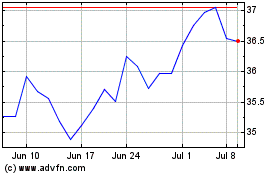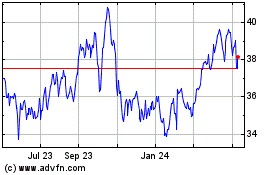BP Sets Break-Even Target at $35 a Barrel
February 28 2017 - 2:16PM
Dow Jones News
By Sarah Kent
LONDON -- BP PLC on Tuesday laid out plans to drive its
break-even oil price down to $35 to $40 a barrel by 2021, asserting
that it can grow again and keep a lid on spending despite a massive
bill from its Gulf of Mexico disaster six years ago.
In a strategic update that detailed the company's plans for the
next five years, the British oil giant said it expects to increase
production by an average of 5% a year from 2016 to 2021 without
expanding its capital budget above its current $17 billion
ceiling.
By 2021, the company expects its exploration and production unit
to generate free cash flow of $13 billion to $14 billion at oil
prices around current levels, above $55 a barrel on the ICE futures
exchange recently. This year the company expects to need oil prices
at $60 a barrel just to break even.
"You have a company that is getting back to growth--growth
today, growth in the medium term, and growth over the very long
term," Chief Executive Bob Dudley told investors.
It is a narrative the company is emphasizing after years spent
retrenching following its fatal 2010 blowout in the Gulf of Mexico,
coupled with a dramatic decline in oil prices since 2014. It
remains burdened by the fallout from the disaster in the Gulf,
which killed 11 workers, spewed millions of barrels of oil into the
ocean and has already cost nearly $63 billion.
Over the past six years, BP has sold off roughly $75 billion
worth of assets, slashed spending and worked to bring down costs to
cope with the dual challenges of its Gulf of Mexico liabilities and
slumping oil prices.
Management said those changes and progress still to come leave
the company well positioned to grow and compete in a challenging
market. The company said it expects a future in which oil supply is
abundant even as demand for cleaner energy sources is expected to
increase, though it expects oil demand to continue to grow out to
2035.
The company's new oil-price break-even goal of $35 to $40 a
barrel contrasts with its current predicament. BP said in early
February that it had to raise its break-even oil price to $60 a
barrel, and Jefferies, the investment bank, says it is actually
higher than $69 a barrel, the highest among the big Western oil
companies.
According to Jefferies, Royal Dutch Shell PLC, Exxon Mobil Corp.
and Chevron Corp can all break even this year at under $50 a
barrel.
"We're building a company that is competitive in a low-price
environment, " Mr. Dudley said. "We want to be invested in the best
projects in the best basins."
Capital discipline and rigorous cost efficiency remain company
buzzwords.
BP says new projects now through 2020 are expected to generate
35% more cash than the average BP development just two years ago.
Its refining and marketing arm is targeting returns of around 20%
by 2021 and free-cash-flow generation of $9 billion to $10
billion.
More than 200,000 barrels a day of additional oil and gas
production is expected by the end of the decade from recent
acquisitions -- primarily a long-term interest in low-cost oil in
Abu Dhabi -- that top BP executive Bernard Looney described as
"not-to-be-missed" opportunities.
Write to Sarah Kent at sarah.kent@wsj.com
(END) Dow Jones Newswires
February 28, 2017 14:01 ET (19:01 GMT)
Copyright (c) 2017 Dow Jones & Company, Inc.
BP (NYSE:BP)
Historical Stock Chart
From Mar 2024 to Apr 2024

BP (NYSE:BP)
Historical Stock Chart
From Apr 2023 to Apr 2024
